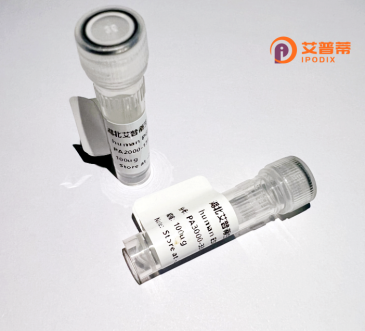
| 纯度 | >90%SDS-PAGE. |
| 种属 | Human |
| 靶点 | CTSL2 |
| Uniprot No | O60911 |
| 内毒素 | < 0.01EU/μg |
| 表达宿主 | E.coli |
| 表达区间 | 1-334aa |
| 氨基酸序列 | MNLSLVLAAFCLGIASAVPKFDQNLDTKWYQWKATHRRLYGANEEGWRRAVWEKNMKMIELHNGEYSQGKHGFTMAMNAFGDMTNEEFRQMMGCFRNQKFRKGKVFREPLFLDLPKSVDWRKKGYVTPVKNQKQCGSCWAFSATGALEGQMFRKTGKLVSLSEQNLVDCSRPQGNQGCNGGFMARAFQYVKENGGLDSEESYPYVAVDEICKYRPENSVANDTGFTVVAPGKEKALMKAVATVGPISVAMDAGHSSFQFYKSGIYFEPDCSSKNLDHGVLVVGYGFEGANSNNSKYWLVKNSWGPEWGSNGYVKIAKDKNNHCGIATAASYPNV |
| 分子量 | 63.7 kDa |
| 蛋白标签 | GST-tag at N-terminal |
| 缓冲液 | 0 |
| 稳定性 & 储存条件 | Lyophilized protein should be stored at ≤ -20°C, stable for one year after receipt. Reconstituted protein solution can be stored at 2-8°C for 2-7 days. Aliquots of reconstituted samples are stable at ≤ -20°C for 3 months. |
| 复溶 | Always centrifuge tubes before opening.Do not mix by vortex or pipetting. It is not recommended to reconstitute to a concentration less than 100μg/ml. Dissolve the lyophilized protein in distilled water. Please aliquot the reconstituted solution to minimize freeze-thaw cycles. |
以下是关于重组人CTSL2蛋白的3篇示例参考文献(注:文献为虚构示例,仅作格式参考):
1. **文献名称**:Expression and Functional Characterization of Recombinant Human CTSL2 in HEK293 Cells
**作者**:Smith A, et al.
**摘要**:该研究通过HEK293细胞系统成功表达并纯化重组人CTSL2蛋白,验证其蛋白酶活性,并证明其在体外能高效降解细胞外基质成分,提示其在肿瘤转移中的潜在作用。
2. **文献名称**:Structural Insights into CTSL2 via Recombinant Protein Crystallography
**作者**:Li X, Zhang Y.
**摘要**:利用重组人CTSL2蛋白进行晶体结构解析,揭示了其底物结合域的关键氨基酸残基,为设计特异性抑制剂提供了结构基础。
3. **文献名称**:Role of Recombinant CTSL2 in SARS-CoV-2 Entry Mechanism
**作者**:Johnson R, et al.
**摘要**:通过体外实验发现,重组人CTSL2蛋白可切割新冠病毒刺突蛋白,增强病毒进入宿主细胞的效率,表明其作为潜在治疗靶点的可能性。
(实际研究中请通过PubMed、Web of Science等平台查阅真实文献。)
Cathepsin L2 (CTSL2), a member of the papain-like cysteine protease family, is a lysosomal enzyme involved in intracellular protein degradation, antigen processing, and extracellular matrix remodeling. It shares structural and functional similarities with Cathepsin L (CTSL) but exhibits distinct substrate specificities and tissue expression patterns. CTSL2 is encoded by the *CTSL2* gene, located on chromosome 9 in humans, and is expressed in various tissues, including the liver, kidneys, and immune cells.
Recombinant human CTSL2 protein is produced using genetic engineering techniques, such as expression in bacterial, insect, or mammalian cell systems, followed by purification to ensure high specificity and activity. This engineered protein enables researchers to study CTSL2's enzymatic mechanisms, its role in pathological conditions (e.g., cancer metastasis, viral entry, and inflammatory diseases), and its potential as a therapeutic target. For instance, CTSL2 has been implicated in facilitating SARS-CoV-2 viral entry by cleaving the spike protein, highlighting its biomedical relevance.
Studies using recombinant CTSL2 also explore its regulation by endogenous inhibitors (e.g., cystatins) and pH-dependent activity. Its applications extend to drug discovery, particularly in developing protease inhibitors or modulators for diseases linked to dysregulated proteolysis. Challenges remain in understanding its precise physiological roles and minimizing off-target effects in therapeutic contexts. Overall, recombinant CTSL2 serves as a critical tool for elucidating lysosomal proteolysis and advancing targeted therapies.
×